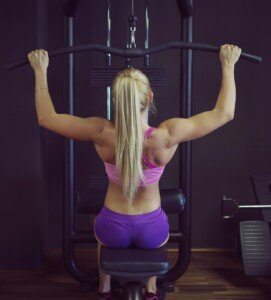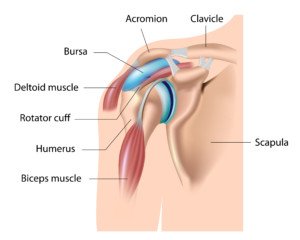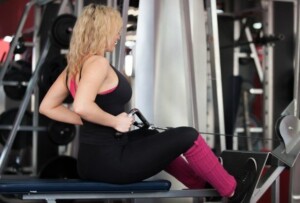
Everyday motions can strain the rotator cuff and even prevent healing. You likely don’t even realize when a particular movement is bad for your rotator cuff.
The rotator cuff is a group of four muscles and their delicate tendons.
These muscles enable the shoulder to move in different ways.
Stand with your arms hanging straight at your sides.
Now, slowly lift them up at your sides, keeping them straight, palms facing the floor. Keep shoulders relaxed.
Do you feel pain or anything irksome in one or both shoulders? If so, chances are, this is a rotator cuff problem, mainly with the supraspinatus rotator cuff muscle.
There are other ways to test for a rotator cuff problem, but I won’t go into them here since they are tricky to describe.
However, another classic sign is that when you reach up for something, like grabbing something off the top of the refrigerator or a high shelf, you feel an uncomfortable tweak, ache or pain in your shoulder.
If you lift weights, a rotator cuff problem will be obvious when you do the following exercises: bench press, pushup, behind-the-head shoulder barbell press, and sometimes, wide-grip pull-downs and dumbbell presses (depending on amount of weight).

Freepik.com, ArthurHidden
Everyday movements that can cause, or aggravate, rotator cuff problems.
One: When you feed your arm into a coat arm or jacket arm, your palm faces the floor.
The joint motions here are shoulder internal rotation, and shoulder abduction.

Shutterstock/Milles Studio
These two joint motions in combination “crowd out” the air space at the rotator cuff, and can actually result in the humerus bone of the upper arm making contact with a rotator cuff tendon.
Over time, the bone frays the edge of the tendon. To prevent this, when you feed your arm into an arm hole, do it with 1) your palm up, and 2) your arm as bent as you can.
This creates an opening in the joint, which gives the humerus more room, and thus, it does not contact the tendon.
Two: When you reach for high objects, your palm is facing down. When you hold the object and lower your arm, your palm is facing down or sideways.

Shutterstock/Milles Studio
Again, this palms-down motion crowds out the joint, bringing the humerus bone too close to the tendon.
When you reach up for that jar of pickles or whatever, face the palm to the ceiling.
After grabbing the jar or item, hold it with the palm facing the ceiling as you lower your arm. In other words, always have a palms-up approach.
Three: “Some movements that can put your shoulder muscles at inefficiency can be reaching to put your bag in the back seat [or retrieving something from there] when you’re sitting in the front of the car,” says Dr. Megan McLain, PT, DPT, cofounder of Intuitive Choice Physical Therapy & Wellness in Atlanta, GA.
Similar to this is draping a jacket or sweater over the passenger seat of the car when you’re driving.
In both cases, the rotator cuff will be aggravated most when your palm is down.
This is bad news. It crowds out that glenohumeral space.
Perform these actions with the PALM UP. And keep the arm bent as much as possible.
Additional Movement Patterns that Are Bad for the Rotator Cuff
“Another is lifting an object that is too heavy for one arm like a barrel or heavy groceries that can overload the joint and muscle’s capabilities, straining the rotator cuff,” says Dr. McLain.
“Repetitive overhead work is also a risk factor for rotator cuff tears.
“Also, quick movements like trying to catch a heavy object from falling or yourself from falling also can overload the rotator cuff tendon’s ability to stabilize the joint.”
What’s going on inside the rotator cuff?

The rotator cuff. Shutterstock/Alila Medical Media
“The reason that the glenohumeral space can become crowded is partly because of the way the shoulder is constructed,” says Dr. McLain.
“The head of the humerus is larger than the glenoid fossa, so the rotator cuff and the labrum both help to provide extra stability to the joint.
“Think of it similarly to how chocks can stabilize a whole airplane. Poor posture or overworking a certain group of muscles with repetitive motions can lead to faulty mechanics at the shoulder, which most often leads to the head of the humerus to translate up and forward relative to the glenoid.
“This can lead to something called subacromial impingement, which is the tendons rubbing against the bone and becoming frayed.
“This happens because the bicep and one of the rotator cuff tendons run under the acromion, which is the hook on the side of the shoulder.
“This space gets relatively smaller with poor mechanics and overhead lifting, in particular.”
Strength Training Will Help
“Strength training that can be done to counteract this is for the muscles at the back of the shoulder, meaning the scapular muscles,” says Dr. McLain.
“This can include exercises like bent-over rows and pulling tasks.

Bent-over dumbbell row. George Stepanek
“Also working the biceps and triceps, especially if you do a lot of carrying or lifting, is also important to protect the smaller, stabilizing rotator cuff muscles.
“You should be mindful of your body position and avoid trying to lift objects that are too far away from your body.
“Move closer before lifting and use two hands to evenly distribute forces.”

Another pulling motion, the seated row. Start out with very light weights and gentle motion. Freepik.com yanalya
 Dr. Megan McLain, PT, DPT, puts her clients first while providing one-on-one in-home care. With physical therapy and health coaching services, Dr. McLain addresses all aspects such as physical barriers, mindset, accountability and knowledge that may be impacting the client’s experience.
Dr. Megan McLain, PT, DPT, puts her clients first while providing one-on-one in-home care. With physical therapy and health coaching services, Dr. McLain addresses all aspects such as physical barriers, mindset, accountability and knowledge that may be impacting the client’s experience.
 Lorra Garrick is a former personal trainer certified through the American Council on Exercise. At Bally Total Fitness she trained women and men of all ages for fat loss, muscle building, fitness and improved health.
Lorra Garrick is a former personal trainer certified through the American Council on Exercise. At Bally Total Fitness she trained women and men of all ages for fat loss, muscle building, fitness and improved health.
.









































